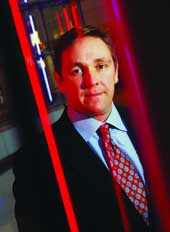Worlds collide

ERP and SOA start to play together.
Enterprise resource planning and service-oriented architecture are coming together. Three of the major software vendors of ERP software are moving their own platforms to ones that support Web services.Oracle Corp. is rolling out its Fusion platform, which updates the PeopleSoft HR software with Web services interfaces. Already, its Fusion Middleware allows users to build their own composites, or applications that reuse already-existing functionality in other programs, said Wayne Bobby, vice president for solutions for finance and administration at Oracle Federal.Likewise, SAP AG, based in Waldorf, Germany, has migrated its MySAP ERP software to a new Web services-based platform called Netweaver.It is now exposing all the core functionality as Web services. So far, more than 1,500 functions are available. "We are going to expose every single element of our solution as a Web service," said David Ditzel, director of public services technology solutions for the company.In a similar move, CGI Inc. of Montreal has migrated its federal ERP software, called Momentum, to a Java 2 Enterprise Edition-based platform, allowing developers to easily hook their own J2EE applications into CGI's software, said Heidi Green, head of CGI's state and local ERP practice, based in Fairfax, Va.ERP systems traditionally are known as large, monolithic applications that tend to be difficult to install, maintain and upgrade. SOA promises to make software more responsive, namely by making it easy to reconfigure to meet changing needs. Could these two work well together?A government agency might buy an ERP system "every 10 years or so," Green said. A component-based approach could allow agencies to add new functionality over time "at a reasonable cost," she said.In many ways, the federal government has tried to simplify ERP deployment by breaking the job into smaller chunks. For instance, when the Social Security Administration wrote the business case for a new core financial-management system in 2001, it broke fiscal duties into discrete functionalities, following Clinger-Cohen Act tenets to mitigate risk, said Tom Bianco, who manages the Social Security Online Accounting and Reporting System.SSA's system uses components of the Oracle Federal Financials package, including the general ledger, accounts payable, accounts receivable and purchasing modules.With Web services-based interfaces, the modular approach could now become more fine-grained, advocates said. Instead of one component handling all supply chain management, for instance, multiple components could be called out to handle tasks such as supply credit check or check inventory. Vendors would still integrate these components into larger offerings, such as one for supply chain management, but users also could apply selected features to their own needs.With these components, organizations could build composite applications, or applications that draw both data and processes from existing systems, said Michael Grim, head of public services business development for SAP.The need to build composite applications certainly seems to be growing. Increasingly, managers are calling for applications that can draw from multiple systems, he said.For example, Maryland legislators have enacted a law that would prohibit individuals from renewing a driver's license if they owe back taxes to the state. While a good idea in theory, the operation involves the system that handles tax data and the one that handles license renewals.By having individual functions within these systems exposed, organizations can then have their own specialized ap-plications built. "So if you want to create a new composite application, we'll give you a Web service-based way of getting at that information in SAP," Grim said.A composite application that intermingles other programs with SAP's MySAP ERP offering could be built either through SAP's own Netweaver Developer Studio or in a non-SAP development environment, Ditzel said.For example, Adobe Systems Inc.'s PDF-based documents can act as electronic forms that can be filled out by a user at a computer, Ditzel said. When the form is saved, the user-generated data is formatted in Extensible Markup Language, using a schema of the organization's choice.A developer can use Adobe Acrobat to design electronic forms that look like an organization's paper forms. All the fields to be filled out by the user could correspond to a data model within an organization's SAP system. The developer could then create a composite application that routes the XML-encoded information into the SAP system. When a user fills out such an electronic form, the data could be automatically inserted into the ERP system.This has numerous advantages, Ditzel said. Data can be entered into an ERP system without users actually having to log into the system. An organization can preserve the look and feel of its paper forms through Adobe's software, rather than going with SAP's own less-powerful form designer. For the user, fields could be prepopulated, using information from the ERP database. And the organization can also take advantage of Adobe's PDF-based workflow capabilities.SAP has long published the interfaces to its software under the name of Business Application Programming Interfaces, or BAPI, Grim said. It also has offereda Cobol-like programming language, called Advanced Business Application Programming.What is new is that the company is using industry standards. Grim admitted the old interfaces were "SAP-centric."An organization could use Netweaver to work with the SAP software through Web services and the Java programming language, capabilities that are more broadly available.So a process such as combining Adobe's PDF support software and MySAP has grown dramatically easier, Ditzel said.Oracle offers a similar approach with its Fusion Middleware, allowing customers to build unique applications by using Web services and J2EE specifications."There are functions that these agencies perform that will never exist in a commercial, off-the-shelf application," Bobby said.Such a composite-based approach is the basis for SOA.As the Organization for the Advancement of Structured Information Standards said last summer, the SOA Reference Model is "a paradigm for organizing and utilizing distributed capabilities that may be under the control of different ownership domains."By reusing capabilities, theorists say, organizations could make better use of available resources or meet changing needs more quickly. SOA is certainly on the radar of Army ERP managers, even if its arrival is some time away."We're looking at [SOA] pretty closely across the Army," said Catherine Doolos, program manager for the Single Army Logistics Enterprise program. She admitted that the service is not ready to move to a component-based approach, though the signs point in that direction.Right now, ERP integration is the chief aim of the Army, Doolos said. And in this regard, the Web services approach is helping the Army integrate complex systems. Her office is working on a Netweaver implementation that will integrate the Global Combat Service Support-Army field logistics system with the service's national logistics system, handled by the Logistics Modernization Program.This bridge program, called Product Lifecycle Management Plus, is scheduled to be implemented by 2010.A bridge between the two systems will allow a universal view across the entire logistics system, Doolos said.A clerk requesting a part can see where that part is in the supply chain. Budget analysts looking at the total number of parts being ordered can get up-to-date data. "The Army wants to trace that transaction all the way back up to the national level," Doolos said.Making this happen, however, is a challenge in integrating different systems. "We spend a lot of time putting together end-to-end business processes," she said. Newer tools such as Netweaver are not much easier to use than those offered 10 years ago. "It is equally ... difficult. It's difficult to do software development," Doolos said.

Bits and pieces
Industry standards
Joab Jackson is an assistant managing editor with Government Computer News. He can be reached at jjackson@1105govinfo.com.

"So if you want to create a new composite application, we'll give you a Web service-based way of getting at that information in SAP." ? Michael Grim, SAP
Rick Steele
Bits and pieces
Industry standards
Joab Jackson is an assistant managing editor with Government Computer News. He can be reached at jjackson@1105govinfo.com.
NEXT STORY: Spectrum wars

